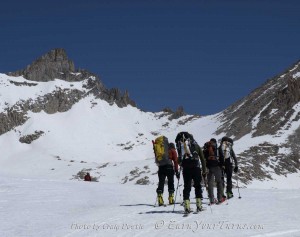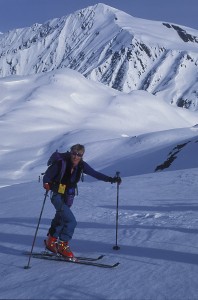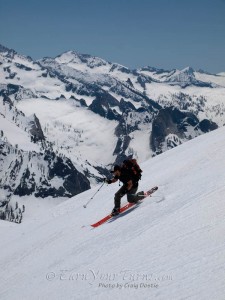Which is why, even though skiing has always been a luxury, you need not be in the well-moneyed class to enjoy it. As Yosemite climber Erik Beck pointed out, “At either end of the social spectrum lies a leisure class.” Thus there are always two ways to make turns. Buy ‘em or earn ‘em.
Despite recent proclamations of recessionary emergence, discretionary income remains in short supply for most Americans. In fact, dropping money to ride the lifts could be considered downright reckless in these tough economic times, especially if it’s courtesy of a loan from “Sharky,” your friendly credit card bankster. For those who have seen the light, this way is sneeringly called burning your turns. You can get a lot of turns per day this way, but their memory fades fast.
More skiers on the road less traveled
Although it is undeniably the way less traveled, backcountry skiing is growing. Since 1995 the number of backcountry skiers in America has grown to a respectable half million or so (or more depending on who you believe). Instead of riding chairlifts, you earn your turns the old fashioned way—by hiking up.It sounds painfully laborious and agonizingly slow. Compared to riding a chairlift, it is. Except that once you’ve done it, you soon realize the uphill leg has a unique dividend structure. As you’re headed up, each step gives you a taste of the conditions you’ll be skiing back down in. The anticipation fuels the desire and once you’ve tasted ‘em you will agree, turns taste sweeter when earned with sweat; the saltier, the better.
Dividend 1: The workout
While you’re hiking up you’re getting an awesome physical workout. It’s similar to cross-country skiing, where you get a total body workout. Instead of gliding through a meadow, you’re hiking up a mountain. Arms are used for balance and pushing power. Legs do the brunt of the work, hiking up the mountain at a steady pace with no jarring motion to your knees while your heart and lungs are pumping double-time to feed your limbs. While you climb, toxins leak out your pores, cleansing and honing your body while sharpening your mind.
Did I mention there aren’t too many out of shape backcountry skiers? Some even tip the scales of Olympic caliber fitness, ready to scale the world’s highest peaks, and then rip turns down their flanks afterwards. In fact, many more would if it weren’t for that ol’ money issue (transportation to the snow remains).
Dividend 2: Balm for your soul
For some, the workout is reason enough to head out, but life is more than our physical surroundings and being. The beauty of the mountains in winter rarely fails to give one pause to consider the spiritual realm. The mere act of skinning up a mountain, with the emphasis on a steady, rhythmic pace acts as a natural inducement for meditation. It’s a perfect time for quiet reflection, a soothing balm for the soul, and conversation with friends mixed in.The soul balm is perhaps the greatest enticement and payback for your investment in earning your turns. If part of what you enjoy about skiing is getting out of the rat race, you’ll appreciate even more that you’re making new lines, not standing in them. By leaving the lifts, you leave the crowds and enjoy a bit of solitude and camaraderie with friends only. At the end of the day you may make fewer turns, but you’ll be satisfied because you were able to savor them, even look back and admire them. Such views are fleeting at best under the lifts where turns are burned in a futile attempt to beat the crowd to patches of untracked snow. In the backcountry, there’s no race, and the whole slope is waiting for you to leave your tracks.
Dividend 3: Economic value
Finally, there are the simple economic reasons for becoming a backcountry skier. I had to experience a bit of financial hardship myself before I was willing to hike for my turns. On my maiden backcountry tour I brute-forced my way up the slope, kicking steps in ski boots. Serendipitously it was perfect, spring corn conditions and the turns were sublime. Even though I enjoyed the climb from a workout perspective, I knew there had to be a better, more efficient way of doing it. It was an awful lot of work, even though the turns were more satisfying.Indeed, it’s amazingly simple. Just buy a pair of Alpine Touring (AT) bindings and a pair of climbing skins. If you’re already a slope dopin’ downhill skier, the investment is small. About $600 new, or half that if you pick up used bindings and a new (recommended) pair of skins.
AT bindings release at the heel, allowing you to walk with your skis on, fairly naturally, with your heel unhinged, pivoting at the toe. Go ahead and keep your existing alpine ski boots, just unbuckle the cuff while skinning. Once you’re hooked you’ll want to change those too, but there’s no point in spending too much money until you need to.
The climbing skins allow you to walk uphill with your skis on without sliding backwards. In the right conditions you can go straight up a 30° slope, which is about as steep as most black diamond runs are at most resorts. Straight up. You don’t have to, it’s much easier to go at a more moderate angle, but the macho guys seem to like grunting up a tougher, steeper trail.
Cash Costs
Once you’ve been bitten by the backcountry bug there will be more “investments” down the road. So the question arises, do the economic costs still favor backcountry skiing?
Consider the chart below that compares equipment costs of skiing 20 days per year for five years. This assumes that within five years all gear will need to be purchased anew at least once, and that it will last five years. It includes required and some recommended equipment. Lift tickets are valued at $50. Though this is less than the average lift ticket cost, the reduction is made to account for the effect of discounting via season passes.
| Item |
Resort Cost
|
BC Cost
|
Comment |
| Skis |
$500
|
$500
|
Required |
| Boots |
$500
|
$500
|
Required |
| Bindings |
$200
|
$400
|
Required |
| Poles |
$50
|
$100
|
Required |
| Lift Tickets |
$5000
|
$0
|
Recommended |
| Climbing Skins |
$0
|
$150
|
Required |
| Sub Total |
$6250
|
$1650
|
|
| Pack |
$100
|
$150
|
Required |
| Airbag Pack |
$0
|
$1500
|
Recommended |
| Avalanche Beacon |
$0
|
$300
|
Required |
| Shovel |
$0
|
$100
|
Required |
| Avalanche Probe; |
$0
|
$80
|
Required |
| Clothing |
$600
|
$800
|
Recommended |
| Class/Lessons |
$200
|
$500
|
Recommended |
| Sub Total |
$900
|
$3430
|
|
| Total |
$7150
|
$5080
|
Without including an airbag pack the net savings is about half, with the lion’s share of the difference due to lift ticket prices (Note: the above numbers may be out of date). Now don’t get me wrong, I’m not saying that resort skiing is bad, or even something you want to eliminate.
Earning = Investing
When you invest in earning your turns you end up skiing more. Being able to make turns wherever there is snow, not just where there are chairlifts, opens up amazing possibilities. Your resort days may decline, but your total number of ski days will grow. With the money you save backcountry skiing, you can afford to be selective about the days you do pay for a lift ticket.
As you can see, the only reason not to be a backcountry skier is if you’re not even a skier. And if you’re neither, hopefully I’ve made a compelling case for becoming one. After all, the best investment you can make is in yourself. Backcountry skiing doesn’t cost much to begin, it costs less to maintain, and the longer you do it, the more beneficial it is for you. Health is your basic wealth. So do yourself a favor—invest in yourself and earn your turns. You’re worth it.
© 2010
This article was first published in The Adventure Sports Journal, Jan./Feb. 2010.





2 comments
You forgot $1500 for the used Subaru GL 😉
Good points Dostie.
In my case the doc wanted to put me on meds for cholesterol and high blood pressure. A winter BC took care of both conditions. Now there is the slight complication of having to swap hemispheres to keep it going all year round 😉